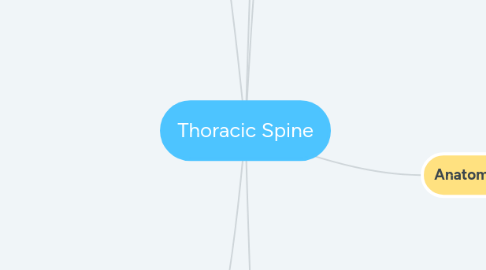
1. Osteology
1.1. 12 Thoracic Vertebra
1.1.1. Typical Vertebrae
1.1.1.1. T2 - T8
1.1.1.1.1. Inferior and superior costal facets
1.1.1.1.2. Nearly coronally oriented articular facets
1.1.2. Atypical Vertebrae
1.1.2.1. T1
1.1.2.1.1. Similar to cervical vertebrae
1.1.2.1.2. Only articulates with 1 rib instead of 2
1.1.2.2. T9
1.1.2.2.1. Lacks bottom costal demifacet
1.1.2.2.2. Only articulates with 1 rib instead of 2
1.1.2.3. T10
1.1.2.3.1. No inferior costal demifacet
1.1.2.4. T11
1.1.2.4.1. 1 facet on each side of vertebra
1.1.2.5. T12
1.1.2.5.1. Superior half is thoracic in character
1.1.2.5.2. Inferior half is lumbar in character
1.1.2.5.3. Subject to transitional stresses
1.1.2.5.4. Mammilary Processes
1.1.3. Parts for Movement
1.1.3.1. Articular Processes
1.1.3.2. Costal Facets
1.1.4. Parts for Attachment
1.1.4.1. Transverse Processes
1.1.4.2. Spinous Processes
1.1.5. Joints
1.1.5.1. symphysis
1.1.5.1.1. fibrocartilage
1.1.5.1.2. between vertebral bodies
1.1.5.2. Facet joints
1.1.5.2.1. between vertebral arches
1.1.5.3. costovertebral
1.1.5.3.1. superior costal facet
1.1.5.3.2. inferior costal facet
1.1.5.3.3. IVD
1.1.5.4. Zygapophyseal
1.1.5.4.1. protect organs
1.1.5.4.2. allow for respiration
1.1.5.4.3. prevent downward flexion of heart and lung
1.1.5.4.4. increases in size as it goes down in spine
2. Nerves
2.1. T1 - T5
2.1.1. Muscles innervated
2.1.1.1. Forearm and hand
2.1.1.2. Upper chest
2.1.1.3. Mid-back
2.1.1.4. Abdominal
2.1.2. Results of injury
2.1.2.1. Affects lower back, abdominal and leg muscles
2.1.2.2. Typically results in paraplegia
2.1.2.3. Arm and hand function usually normal
2.2. T6 - T12
2.2.1. Muscles innervated
2.2.1.1. Abdominal
2.2.1.2. Back
2.2.2. Results of injury
2.2.2.1. Affects muscles of the trunk
2.2.2.2. Usually results in paraplegia
2.2.2.3. Little or no control of bowel or bladder
2.2.2.4. Normal upper body movement
3. Muscles
3.1. Erector spinae
3.2. Transversospinalis
3.3. Interspinales
3.4. Intertransversarii
4. Vasculature
4.1. Posterior Spinal Arteries
4.2. Anterior Spinal Artery
4.2.1. Sulcal Arteries
4.3. Anterior and Posterior Segmental Medullary Arteries
4.4. Great Anterior Segmental Medullary Artery
4.5. Posterior and Anterior Radicular Arteries
4.6. Anterior and Posterior Spinal Veins
4.7. Anterior and Posterior Medullary Veins
4.8. Anterior and Posterior Radicular Veins
5. Anatomical Variations
5.1. Excessive Thoracic Kyphosis
5.1.1. Abnormally shaped
5.1.2. Too much hunch back
5.1.3. More common in women
5.2. Scheuermann’s Kyphosis Disease
5.2.1. Wedge shaped
5.2.2. Tx: back brace
5.3. Potts Disease
5.3.1. TB
5.3.2. Spondylitis
5.4. Hemivertebrae Thoracic
5.4.1. Not fully developed
5.4.2. Congenital scoliosis
5.4.3. 4 types of segmental
5.4.3.1. Fully segmental
5.4.3.1.1. Not fully developed vertebrae
5.4.3.2. Semi-segmental
5.4.3.2.1. Half of vertebrae are fused
5.4.3.3. Non-segmental
5.4.3.3.1. Connected to vertebrae
5.4.3.4. Incarcerated
5.4.3.4.1. Joined by pedicles
5.5. Fused vertebrae
5.5.1. 2+ connected to vertebrae
5.5.1.1. Limited movement
5.6. Thoracolumbar Transitional Vertebrae
5.6.1. Affect thoracic and lumbar region
5.6.2. Overlap of somite
5.6.3. Referred pain
5.7. Rib Variants
5.7.1. Landmark for spine
5.7.2. Vertebral body
5.7.2.1. Right side
5.7.2.1.1. 3rd and 4th ribs
6. Ligaments
6.1. Radiate Ligament
6.1.1. articulate with the head of the rib to the adjacent vertebral body and IVD
6.1.1.1. Superior
6.1.1.1.1. Rib connect to vertebrae above
6.1.1.2. Horizontal
6.1.1.2.1. rib connect to IVD
6.1.1.3. Inferior
6.1.1.3.1. rib anchor to vertebrae
6.2. Costotransverse Ligament
6.2.1. rib attach to transverse process
6.2.1.1. prevent costotransverse joint from gliding
6.2.1.2. support and not dislocate ribs
6.2.1.3. attachment for back extensors
6.3. Superior Costotransverse Ligament
6.3.1. connect upper border of the neck of the rib to the above vertebrae transverse process
6.3.1.1. protect against traction
6.3.1.2. protect against compression of nerves
6.4. Accessory Ligament
6.4.1. seperated by posterior rami of thoracic nerves
6.4.1.1. C8-T11
6.5. Lateral costotransverse Ligament
6.5.1. extends from transverse process to the tubercle of rib
6.5.1.1. protect against traction
6.5.1.2. Protect against compression of nerves
